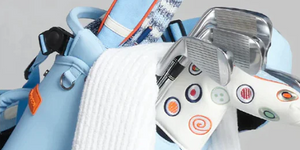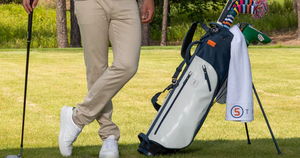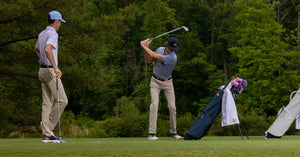Forged vs Cast Irons: What's the Difference?
Golf novices and beginners often wonder about the differences between forged vs cast irons and which is better for their game. Even experienced golfers engage in this debate, but how relevant is it?
Understanding the distinctions is important, but the individual club's construction matters less than finding the one that best suits your personal game.
Forged irons are favored by many pro players, yet the lines between forged vs cast irons are increasingly blurred. In fact, over half of professional golfers use a combination of both.
Let’s delve into the myths and realities surrounding forged vs cast irons.
Forged Irons
How Are Forged Irons Made?
Forged irons are crafted from a single piece of metal, which is stamped or forged into the desired shape. This manufacturing process allows for greater malleability, enabling customization in loft, bounce, and lie angle.
Benefits of Forged Irons
- Look and Feel: Forged irons provide a softer feel upon impact, enhancing player feedback due to their smaller clubhead and slimmer profile.
- Control: These clubs allow for better manipulation of the ball, giving players control over launch angles and flight paths.
- Consistent Construction: The uniformity in manufacturing results in a predictable feel, allowing for greater shot control.
Disadvantages of Forged Irons
- Durability: Forged irons are generally softer and slimmer, leading to quicker wear and visible damage over time.
- Less Forgiving: The smaller sweet spot requires skill and precision, making them less forgiving for mis-hits.
- Cost: The labor-intensive manufacturing process results in higher prices compared to cast irons.
Cast Irons
How Are Cast Irons Made?
Cast irons are produced by pouring molten metal into molds, allowing for more design flexibility. They are often referred to as cavity back irons.
Benefits of Cast Irons
- Enhanced Design: Cast irons offer various pre-molded designs, including channels and perimeter weighting, aimed at improving gameplay.
- Ease of Use: With a lower center of gravity, cast irons help players achieve better shots and build confidence, especially on mis-hits.
- Ball Speed: Cavity back designs typically increase ball speeds.
- Forgiveness: The weight distribution in cast irons helps mitigate the effects of mis-hits.
- Versatility: Available in numerous shapes and designs, cast irons enhance performance across different turf types.
- Cost: Generally, cast irons are more affordable due to a quicker and cheaper manufacturing process.
Disadvantages of Cast Irons
- Feel and Feedback: Cast irons may lack the authentic feel of forged clubs, which can affect feedback on good shots.
- Consistency: Variability in design and construction can lead to less consistent performance.
Forged vs Cast Irons: What Do the Pros Use?
Most professional golfers prefer forged irons for their slimmer profiles and smaller club heads, which provide consistent ball reactions. Pros prioritize control and ball influence over speed, often resulting in fewer mis-hits.
However, as the distinctions between forged vs cast irons continue to blur, many professionals carry a mix of both types in their bags. Ultimately, the best choice depends on the player's needs.
Who Should Use Cast Irons, and Who Should Use Forged Irons?
Cast irons make up about 90% of golf clubs available for purchase. Often associated with game improvement, they are mistakenly thought to be only for beginners.
In reality, forged irons are not exclusive to lower handicap players. Manufacturers design clubs for all skill levels, and many PGA tour players use a combination of both.
Cast irons are particularly beneficial for high handicappers, occasional players, beginners, and seniors due to their larger, more forgiving design. They help novice golfers get the ball airborne more easily, promoting confidence and improving their game.
While some mid-handicapped players may opt for forged irons to refine their technique, mis-hits can lead to poor shots, making them a challenging choice for those still developing their skills.
Budget considerations also play a role; cast irons are typically more affordable, making them a practical choice for newcomers to the sport.
Ultimately, the decision between forged vs cast irons comes down to personal preference. Experimenting with both types will help you determine which suits your game best. Experienced golfers often recommend choosing based on feel.
If the differences between forged and cast irons seem unclear, online tutorials can provide visual explanations of their pros and cons.
The best club for any player is one that complements their game. A professional fitter can assist in finding the right match. Remember, USGA rules limit the number of golf clubs in your bag to fourteen, and additional restrictions apply once play begins.
Frequently Asked Questions
Are Forged Better Than Cast Irons?
This depends on your skill level and playing style. Generally, forged irons are better suited for lower handicap players, while cast irons offer more forgiveness for those still developing their game.
Do Forged Irons Go Further Than Cast Irons?
Cast irons typically generate greater ball speeds due to their loft. Forged irons usually have a weaker loft, but this can vary by manufacturer and specific club design. Lower-handicap players often prioritize control over distance.
Final Thoughts
The pursuit of the perfect golf club is ongoing among manufacturers. As technology evolves, new materials and designs continue to enhance performance.
Even if your clubs are a few years old, you may be surprised by the advancements in feel and performance offered by newer models. The lines between forged vs cast irons are increasingly hybrid, with diverse options available to suit every player's preference.
For the latest and greatest golf bags and golf equipment, explore what Stitch Golf has to offer, including a wide range of golf gear and golf apparel that's tailored for every player and every game.



